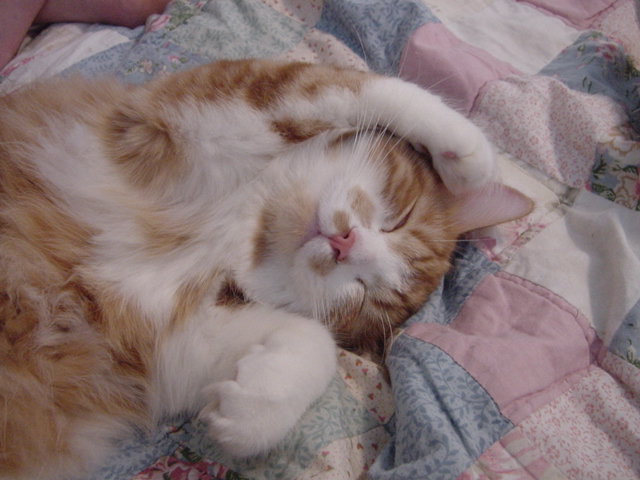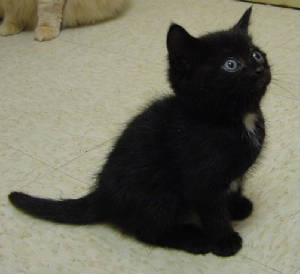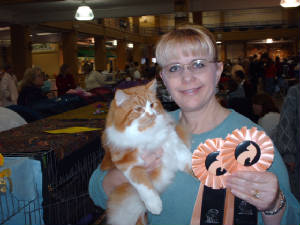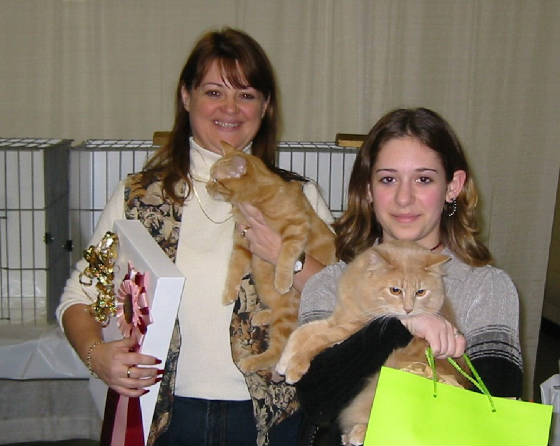|
Region 4

MMQ: I love the way that many of the Manx fanciers use the Gaelic names for
their Manx. I see that you have used "BANNAGHTYN Y" Which is Gaelic for "Greetings". as your greeting to all
Manx fanciers to your website.
KAREN: Thank you Mema. Most of the people who visit my website
are looking for tailless Manx kittens or information about the Manx breed cat. The general consensus is that any tailless
cat is a Manx. So, I try to incorporate information along with facts to make visiting the site interesting as
well as educational.
MMQ: Where are you located? And tell me about your Manx.
KAREN: We are a hobby, home based cattery centrally located in rural Pennsylvania
(Blair County). We work primarily with CFA registered Manx cats. All of our cats are registered with
"The Cat Fanciers' Association, Inc.", more commonly known as CFA and shown at CFA shows. With the addition of our new
stud male September 2005, GC, BW Minusdetails Northern Exposure aka "PJ" through the generosity of Kay and Terry
DeVilbiss some of our cats are registered under two cat registries, CFA and The International Cat Association, more commonly
known as TICA.
MMQ: When did you start to expand your fascination with the Manx?
Did you have a mentor when you started?
KAREN: Karello Cattery was founded in 1996 when I registered my cattery
name "Kar" from Karen and "ello" from my former married name with CFA. Shortly afterward, I purchased my first registered
Manx breeding pair from Barbara St. Georges of Briar-Brae Cattery in New Mexico. Briar-Brae Chi-Chi and Briar-Brae My
Black Sambo. Sambo was out of one of Barbara's cats and one from Jean Brown of Romanxx Cattery in North
Carolina. Jean was my first Mentor.
Barbara St Georges & Casey Joniello holding
GC, GP, RW Karello's Sam's Son

MMQ: Tell us what you feel are the most important considerations a conscientious
breeder must incorporate into their breeding of Manx.
KAREN: Our main goal and focus are producing a sound, healthy,
well socialized registered Manx cat. We feel soundness is most important if you are to be serious about working with
this breed, without soundness you have no solid ground with which to build on. We believe in keeping such strict breeding
standards we and other responsible Manx breeders with such philosophies have improved our breed tremendously over the
past ten years.
MMQ: When someone wants to get a Manx for their personal companion
where would they look for that special Manx?
KAREN: The best place to purchase a Manx is from a reputable, registered
Manx breeder. We post our available kittens on our website. Sometimes we have retired breeders/show cats
and rescues posted as well.
MMQ: My granddaughter has a Manx with a longer coat, are they the same
as the Manx with the shorter coat?
KAREN: There are two types of Manx coats, they are short and
long hair (the long hair was formerly known as Cymric in CFA). The coat length is the only difference there is between the
two names. The short hair Manx has a double coat, the outer guard hairs are somewhat hard, appearance is glossy. A softer
coat may occur in whites and dilutes due to color texture gene link. The long hair Manx has a silky texture to its coat. The
coat is of medium length, with breeches, abdomen and neck ruff that is longer than the coat on the main body. The texture
is silky and soft, it falls smoothly on the body while being full and plush due to the double coat.
MMQ: What variety of colors have your produced in your cattery in either
length of coat?

KAREN: The colors we've produced are Bi-Color (white with unbrindled patches of solid
or tabby patterns) Black, Blue, Blue Classic Tabby, Blue Cream, Blue-Cream and White, Brown Classic Tabby, Calico, Cream Classic
Tabby, Cream Classic Tabby and White, Dilute Calico, Red Patched Classic Tabby, Red Classic Tabby, Tortoiseshell, Tortoiseshell
and White, Solid White (with & without odd eyes).
*One day we hope to add Silver and Black Smoke to our colors produced.
MMQ: Wonderful, what advice do you have for anyone looking for a certain color, sex, coat
length or pattern, are they going to be able to have that special Manx?
KAREN: It helps to be a little flexible when looking for a new pet, the Manx
is a rare breed. If your in a hurry, I wouldn't recommend looking for a specific color sex, coat length or pattern.
A healthy, well socialized kitten will make just as nice of a pet as one with specific outer characteristics.
However, if your intent on a specific characteristic try to stick with a breeder who has produced what your looking for and
has a good possibility of reproducing it again. Don't jump around from breeder to breeder, stick with one and build
a good rapor.
MMQ: Besides all the love and attention to your Manx and breeding program what are the other
adventures have you been taking on?
KAREN: I'm a member of the Manx (and Egyptian Mau) Breed Councils, American Manx Club
and Manx Rescue. I can be seen showing Egyptian Mau's, a Devon Rex and a Maine Coon cat in Premiership class.
This all came about due to my desire to reward my family for being so helpful, supportive and understanding while living
with my Manx and believing it's not fair to force my breed of choice onto them. so, I've indulged each one of them
with their pick of a breed they would like to own. It started with my daughter, Casey, she has always loved the
regal, intelligence of the Egyptian Mau. So, thanks to the generosity of Melanie Morgan of Emau Cattery in
Virginia we now own two Egyptian Mau's, a silver and black smoke. After that my son, Ethan took a turn. He was
very fascinated by the Sphynx breed but with further education he decided it was not the breed he would select at
that time. He was offered a Devon Rex from Kathy Rutledge of Tigerwings Cattery in Virginia and accepted. My husband,
Jody, has wanted a Maine Coon cat for as long as I've known him. When he wasn't sleeping at a show, he could always
be found admiring the Maine Coons in the Maine Coon class. Last year thanks again to the generosity of Teresa Signore
of Highlander Cattery in Ohio, my husband got his wish. He's the proud owner of a 20 lb Maine Coon cat. This concludes
my rewarding adventures with other breeds at this time.

Last show season, I took on my first Protege', Kim Robitaille from Kentucky. Kim purchased
a red tabby and white long hair male from me to show in Premiership. Kim and I named him Karello's Sam's Purrgus
McKitty, "Gus" for short. Kim did a wonderful job grooming and presenting Gus for shows, he earned the title of Grand
Premier in March 06. He was the fifth kitten from LaBearer Red Hot Tumalle of Karello to grand earning Tumalle and I
our first DM.

MMQ: A very big congratulations to both of you, what a wonderful accomplishment !!!
KAREN: Thank You, we were all thrilled with it.
MMQ: Karen, I know that Manx breeders are continually working to make sure ALL "cats in need" are
provided for with new loving homes.
KAREN: I offer a specific web page on my website for those individuals who contact me looking
to find a home for their Manx or Domestic Tailless cat.
MMQ: Karen, thank you for sharing your passion for the Manx with us, and we wish you continued success.
"Slane Ihiu"
[in my Manx dictionary is Goodbye]

|




